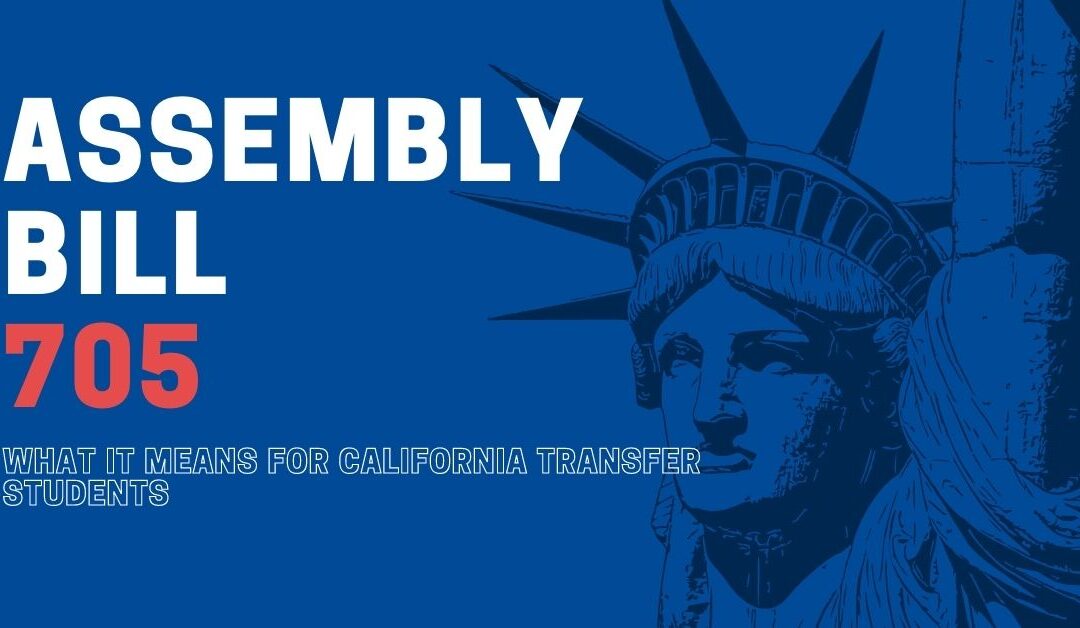Addressing Remedial Courses in Community College with AB 705
Signed into law on October 13, 2017, Assembly Bill 705, or AB 705, took effect on January 1, 2018. Politicians, advocates, and educators have long tried to fix the remedial class problem at the community college level.
AB 705 requires community college districts and individual colleges to enter transfer-level English and Math coursework within one year.
Traditionally, the California community college system depended upon placement and entrance exams in English and Math to determine a student’s class assignment.
More often than not, the student was placed in a remedial or below-transfer level class, which means the math or English class they are taking is not transferable but is instead a prerequisite for transfer-level math or English course.
The objective of this blog post is to explain what AB 705 is briefly and the purpose of AB 705. The article identifies the pros and cons associated with AB 705 and whether or not it has culminated in an enrollment increase in complete transfer level coursework.
Overall, AB 705 is an important step toward ensuring that all community college students have the opportunity to succeed. AB 705 will help place students in math and English courses appropriate for their skills and abilities. This, in turn, will help students stay on track to completing a degree or certificate.
What is AB 705?
Community college students often find themselves in math and English courses that don’t help them maximize their success. These classes are known as remedial courses, and they don’t count toward a degree or certificate.
AB 705 ensures that community college students are placed into English and math courses that will help them succeed.
AB 705 requires California community colleges to consider a student’s high school coursework, high school grades, and high school grades point average when placing them in math and English courses.
By considering high school coursework, high school grades, and other high school factors, students gain access to college level courses that help them stay on track to complete their degree or certificate.
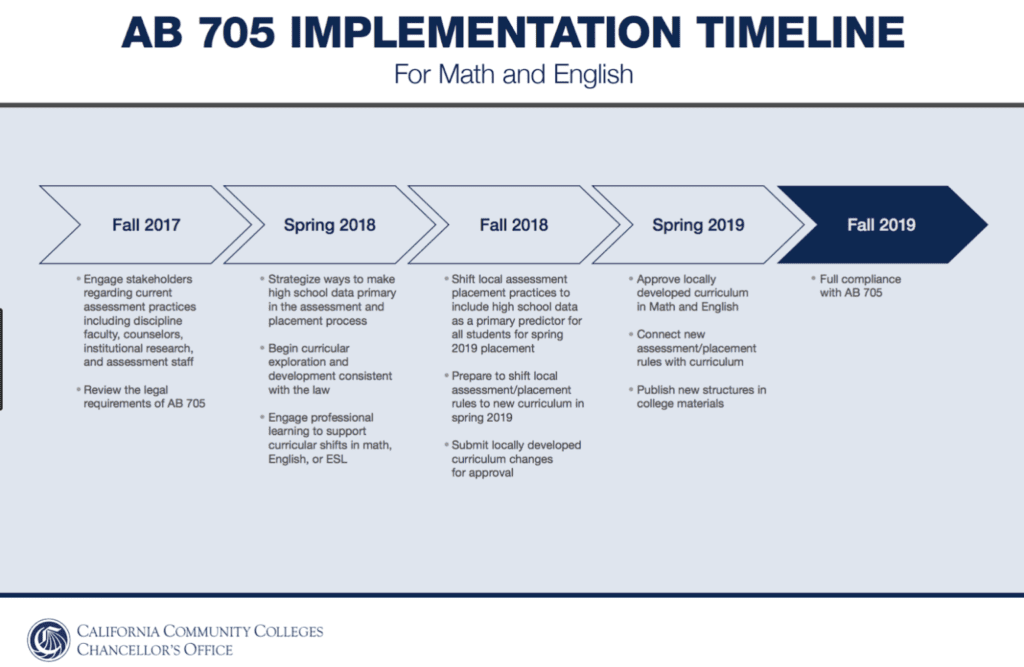
Every community college district should use a student’s high school coursework and high school grades to determine if remedial courses are necessary for the student.
If a student’s high school performance is poor, then some California Community Colleges will identify your standardized placement tests, and any transfer-level courses completed during high school and will be used to showcase your complete transfer level coursework.
Suppose a student received an A in a high school math course. In that case, the community college district should analyze the student’s high school grades and determine if standardized placement tests are necessary.
It’s important to note that AB 705 is not a silver bullet; it will take time and effort to implement AB 705 effectively. However, the focus of the legislation has the potential to make a significant difference in the lives of California Community College students.
A student’s high school performance and high school grades point average is undeniably an indicator of future success in transfer classes when students enrolled can complete transfer level courses and fulfill the transfer requirements set out by the participating AB 705 institutions.
Purpose of AB 705
AB 705, which community colleges started using in the Fall of 2019, was created to reduce the number of students in remedial classes, namely non transfer level English and transfer level math courses.
Students can not decide whether they want to take transfer level courses, including transfer level math courses and transfer level English courses, regardless of their initial placement results.
The inability to take transfer level English and math courses created a problem because it prevented students from completing transfer level coursework within a reasonable timeframe.
These courses were preventing students from transferring to other schools. The reform also addressed unequal course access and completion rates for different racial and ethnic groups.
The earlier a student can complete transfer level coursework, the better because every college maximizes the number of students successfully transferring in a two-year timeframe.
When you complete transfer level coursework, you are setup to apply for transfer admission depending on the articulation agreements between the community colleges articulation office and the participating institution.
Recommended Reading: Transfer College Using ASSIST Org
In the past, community colleges used assessment tests to place new students into math and English courses. However, about 80% of students started remedial or below transfer-level courses.
This approach put students into course sequences that added time and cost to their education—and most students who landed in these sequences eventually left college without transferring or completing a degree.
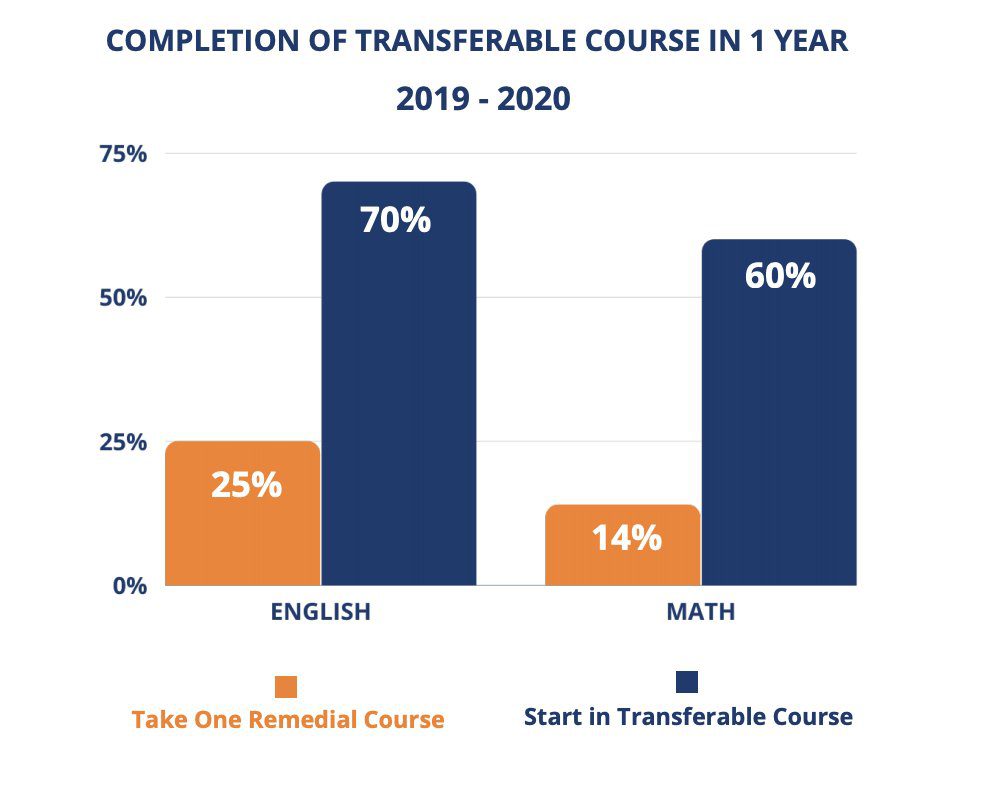
AB 705 Pros and Cons
Pros of AB 705
AB 705 Improves Academic Outcomes
There are various reasons a student would elect to attend a community college. Community colleges are cheaper, and the first two years are spent handling your general education courses (GE), such as your English and Math classes.
As part of the enrollment process, students must take an English and Math placement test to determine their current abilities and skillset.
Before AB 705, the results of that placement test will dictate whether you can successfully transfer in two years (unless a student elects to enroll full-time at community college).
The score one receives from this test is critically important because it affects whether or not one can enroll right away in a transfer-level English or math course.
A bad score can result in the student needing to enroll in a below-transfer-level course to be successful in the transfer-level course. The placement models achieve a specific goal of ensuring students are introduced to course placement in such a way as to ensure they are placed in a successful environment.
Assessment tests are used throughout academia to gauge the intellect of students and determine if they can meet the rigor and demand of the institution.
These classes provide little value to the student as it is not transferable credit and only prolong the student’s ability to transfer in two years. Assessment tests, in this sense, can be a tool that California Community Colleges can utilize in preparing students for transfer level courses.
Too many students get bogged down by the lack of educational progress, so the need to establish regulations governing student course placement is paramount. Allow students to take advantage of a prerequisite course before forcing them to take remedial courses to prove they belong.
AB 705 wants to eliminate the universal approach to placing students in Math or English courses on placement exams.
When students enroll in a transfer-level math course, they are likelier to continue with the second course in the math sequence. California Community Colleges aims to propel students to transfer so they can finish a bachelor’s degree.
However, students are disenfranchised from enrolling at California Community Colleges because they fear that the placement exam and struggling high school grades in math courses could force admission to community colleges for longer than two years.
This is also supported by the fact that most California community colleges have reported an increase in the number of students enrolling in a second transfer-level course to fulfill the English sequence.
AB 705 Increases Student Emphasis
AB 705 places the student at the center of their educational journey and allows counselors and staff to prepare a better transfer plan. Due to AB 705, more students are finishing college composition courses.
In 2019 and 2020, 60 percent of first-time English students (158,000 in fall 2019 and 138,000 in fall 2020) successfully completed college composition in one term, compared to only 27 percent (or 61,000) of first-time English takers in 2015.
Such a dramatic difference can, at least partly, be attributed to the implementation of AB 705, particularly in promoting transfer-level coursework to students who would otherwise refrain from enrolling.
Moreover, the new placement process is simpler and less confusing for students. Colleges are providing students with immediate placement results, which allows students to enroll more quickly in English and math courses.
Moreover, counselors involved in the guided placement say that the initial counseling sessions are more student-centered, with richer discussions about students’ educational goals and pathways, especially for STEM students.
AB 705 Displays a Decrease in Racial & Ethnic Education Gaps
According to the Public Policy Institute of California (PPIC), since the implementation of AB 705, racial/ethnic groups have seen a 30 percent increase in the completion of college composition courses.
For example, successful completion rates among Black first-time English students increased from 15 percent to 47 percent and Latino first-time English students from 20 percent to 55 percent.
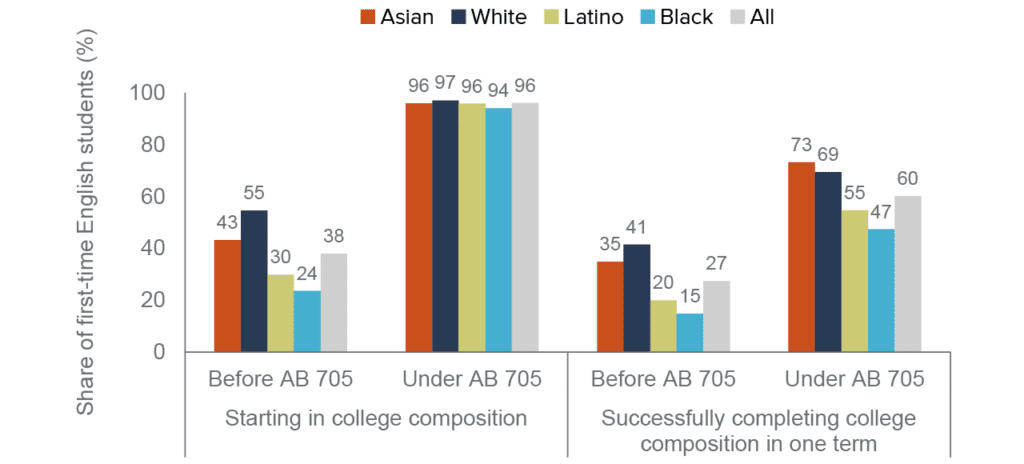
If California wants to close its achievement gap, AB 705 is a solution that cannot be ignored. By intervening and ensuring that poor placement policies do not determine a student’s destiny, we are making capable students more likely to reach their college dreams.
In doing so, time-to-degree will be reduced, and successful student outcomes will increase– benefiting the entire state of California.
Negatives of AB 705
AB 705 Requires California Community Colleges to Buy-In
Since AB 705 has been signed into law and implemented in the California Community College system, various research reports and briefs have noted a universal concern amongst community college faculty and classified personnel who believe AB 705 to be ineffective and may not benefit all students equally.
In particular, some community college faculty argue that implementing AB 705 places an undue burden on faculty concerned about student retention, given that most students lack sufficient academic preparation for transfer-level coursework.
In other words, the rigidity in implementing AB 705 does not allow for much flexibility on behalf of the college to place the student in a below-transfer-level course (BTL), even if it is evident that the student lacks the foundational elements to complete a transfer course in math or English.
AB 705 Can Set Students Up for Failure
AB 705 was created primarily to increase the number of transfer students; however, in doing so, it inadvertently decreased diversity and ignored the needs of returning students.
A student who fails transfer-level math or English course three times is likely to become discouraged and give up on getting a better job. Likewise, single, working parents often cannot complete the required math and English classes within one year.
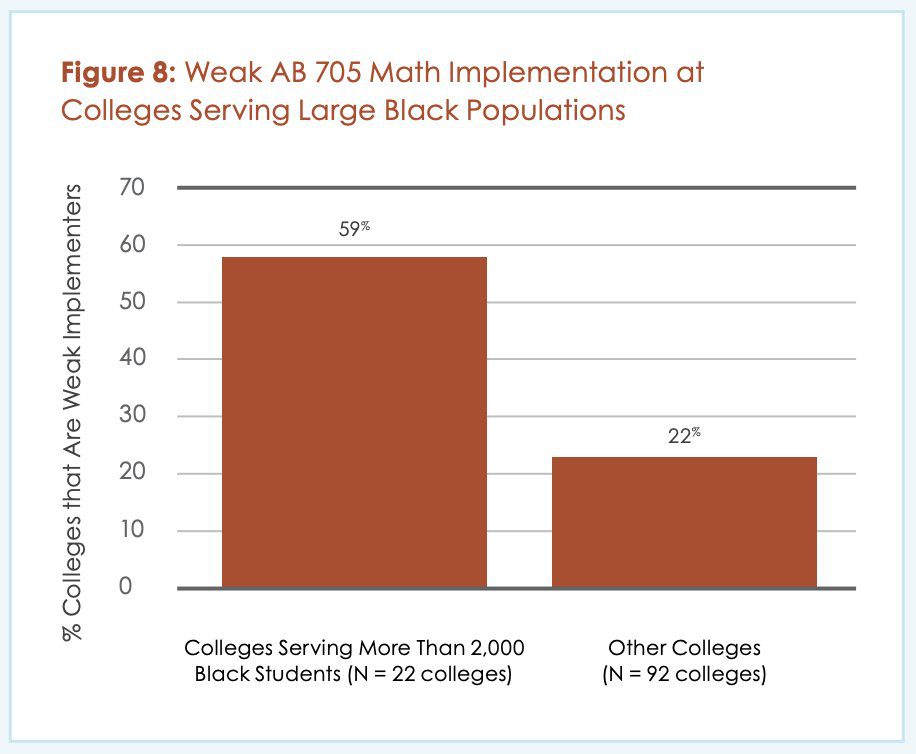
For example, if a single mother is encouraged to enroll in 15 units, often including difficult math or English transfer class, she is likely doomed to fail.
Unfortunately, many students feel belittled when advised to take an easier developmental class at an adult school; they see this as proof that community colleges lack faith in their abilities.
Consequently, rather than fighting for a better future, these disappointed and discouraged students abandon college altogether and return to old lifestyles, leaving them feeling unfulfilled.
AB 705 was founded on unrealistic ideals that all students are able or want to earn degrees within two years, which is not true for many across California. Because of this, AB 705 has caused many problems for students with different circumstances.
AB 705 Lack of Data Collection Standards
According to the PPIC report, only 7 of the 115 California community colleges were adequately implementing AB 705. Most California community colleges reported student enrollment in Below Transfer Level courses (BTL).
BTL courses are considered prerequisites for transfer-level coursework, and enrolling in BTL classes does not increase the completion rates of transfer-level coursework.
Related: What is the California Community Colleges Chancellor’s Office?
Moreover, California community colleges have demonstrated issues reporting due to the lack of data measurements, the submission of incomplete data frameworks, or the sample size for evaluation being too small.
AB 705 authorized the Board of Governors to establish rules and regulations concerning placement models, instruments, and multiple measures.
Final Thoughts on AB 705
Despite the concerns with AB 705, many believe that the benefits outweigh the negatives. Although AB 705 has faced some challenges in implementation, supporters of AB 705 believe that it can help to ensure student success and increase graduation rates across California.
The California Community College Chancellor’s Office has a job to implement the responsibilities tasked by AB 705.
If done correctly, it is likely that higher education in California will rise in competitiveness as more students meet the transfer requirements, learn a second language, and finish prerequisite courses and college-level coursework.
Ultimately, AB 705 provides an important framework for increased collaboration between faculty and administrators, which is vital to student success.
AB 705 has a domino effect affecting other aspects of a student’s life, such as financial aid implications, higher education concerns, and the prospects of completing higher-level English and Math courses.
What are your thoughts on AB 705 and its implementation in California community colleges? Do you think it is a step in the right direction for student success, or do you believe that there are other approaches that would be more effective?
Share your thoughts in the comments below!

